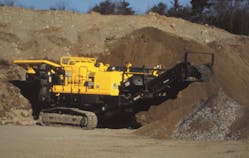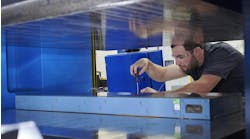Necessity is the mother of invention. These sage words certainly hold true with mobile equipment. Decades ago, single purpose machines were developed to perform required tasks. But as the need for higher production and lower capital equipment costs became necessary, manufacturers began developing machines that could perform multiple functions. The net result has been that operators can now purchase one machine that performs the work of what used to require two, three, or more specialty machines — and usually with higher productivity.
Komatsu’s BR380 JG-1 mobile crusher certainly fits the bill of a high-production machine. Likewise, it performs multiple functions, so owners can use this one machine to perform a variety of operations. And hydraulics is the essential element of this multifunctionality and high productivity.
Hydraulics powers everything
The BR380 JG-1 is powered by Komatsu’s SAAD102-E engine, which is rated 180 hp at 2050 rpm. The engine drives a pair of variable-displacement piston pumps rated for 61 gpm each and pressure to 5405 psi for the main hydraulic system. The hydraulic system’s reservoir holds up to 63 gal of fluid, roughly half the rated flow in gpm. The mobile crusher uses the same track drive and undercarriage as Komatsu’s hydraulic excavators and can achieve a speed of just under 2 mph.
Each of the two track drives is powered by a motor that can handle flow to 42 gpm. A hydraulic track adjuster maintains track tension to maximize component life. Other hydraulic functions include a crusher drive, which takes up to 61-gpm of fluid, a grizzly feeder motor rated for 15 gpm, and a conveyor motor that can accept flow to 10 gpm.
Maximizing efficiency and controlling all this power is left to Komatsu’s HydrauMind (Hydraulic Mechanical Intelligence New Design System) feature. HydrauMind is a closed-center system that uses pressure compensation and load sensing to optimize operation and energy efficiency of multiple functions simultaneously.
Operation at a glance
As bulk material is loaded into a hopper, a the grizzly feeder directs the load into the crusher. The feeder consists of a 40-in. by 121-in. platform that vibrates, which moves material into the crusher. The vibration is generated by a hydraulic gear motor that drives the platform directly at a frequency of just over 18 Hz with a maximum amplitude of 0.4 in.
After material leaves the grizzly feeder, it enters the crusher, which is driven through a V-belt drive by a hydraulic motor at speeds that can vary from 170 to 330 rpm, depending on condition requirements. The inlet port of the crusher is 42 by 22 in., and material leaves the crusher though a discharge aperture that can be set at 2.0 to 5.9 in. The crusher can process up to 265 tons of material per hour.
The greatest innovation of the BR380JG-1 is the crusher itself. Traditional jaw crushers protect themselves by allowing toggle plates to bend if the crusher becomes clogged or jammed. However, the BR380’s crusher protects itself via a locking cylinder mechanism to completely open the discharge port, which makes it easy to extricate clogged material. The crusher’s automatic discharge setting adjustment system also makes it easy to change the discharge port aperture. As either or both jaw plates wear, the operator can adjust the discharge clearance via a simple one-touch operation.
Fine crushed material leaves the discharge area and is carried away by a conveyor. Driven by a hydraulic piston motor, the conveyor can achieve speeds to 394 fpm. A hydraulic conveyor lift raises components to increase ground clearance, which aids maneuverability, especially when traveling over rough terrain.
Click here for more information on the BR380JG-1 crusher.


